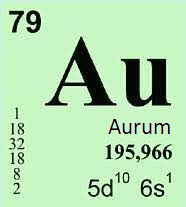Gold is a chemical element with the symbol Au and atomic number 79.

Physical properties of gold
- Gold has a bright yellow color, which makes it highly recognizable.
- It is a soft and dense metal, with a density of 19.3 g/cm3.
- Gold is a good conductor of electricity and heat.
- It has a melting point of 1,064 degrees Celsius and a boiling point of 2,807 degrees Celsius.
Chemical properties gold
- Gold is a relatively unreactive metal, which means it does not easily react with other elements or compounds.
- It is resistant to corrosion and oxidation, which makes it highly valuable for use in jewelry and other decorative applications.
- Gold can form compounds with other elements, such as cyanide, chlorine, and sulfur, among others.
Other Properties gold
- Gold is a precious metal that has been valued for thousands of years for its rarity, beauty, and usefulness.
- It is a highly sought-after commodity and is used in a wide range of applications, including jewelry, coins, electronics, medicine, and dentistry, among others.
- Gold is also used as a store of value and is often seen as a safe-haven asset during times of economic uncertainty or market volatility.
Іsotopes of gold
Gold has one stable isotope, which is 197Au, meaning it has 197 nucleons (protons and neutrons) in its nucleus. However, there are several radioactive isotopes of gold that have been identified, including 195Au, 196Au, 198Au, 199Au, and 200Au, among others.
Of these radioactive isotopes, the most stable and well-known are 195Au and 198Au. 195Au has a half-life of 186.1 days, meaning it takes that amount of time for half of a sample of this isotope to decay. 198Au has a longer half-life of 2.7 days, which makes it useful in medical applications such as cancer treatment.
Radioactive isotopes of gold can be produced through nuclear reactions, such as neutron capture or proton bombardment. These isotopes are used in a variety of applications, including medical imaging, cancer treatment, and research into the properties of gold and other materials.
